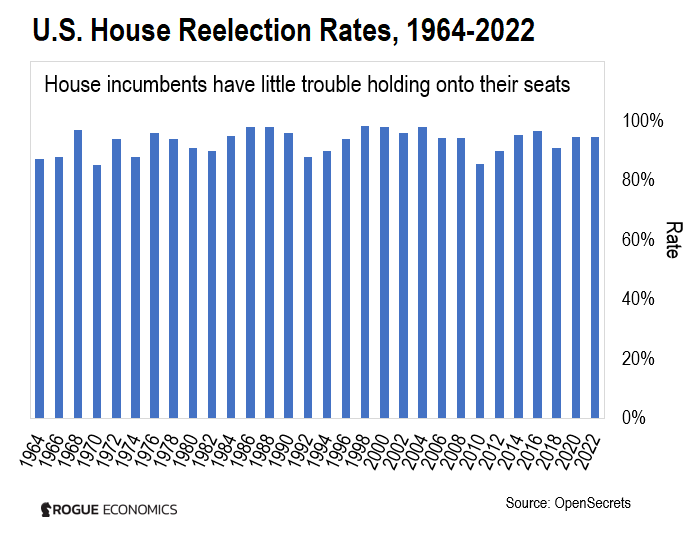Yesterday, I wrote to you about the topic of congressional term limits – an issue many readers have been curious about.
I explored the history of term limits, why our Founding Fathers rejected the idea, and what the process of imposing term limits would legally look like.
Today, I promised I would delve into how term limits are all about the money.
That’s because congressional incumbents stay in power due to the money and corporations backing them… and if you keep your eyes on where this money is originating from, you can have a pretty good idea of which companies will be the government’s winners this year.
But first, let’s take a look at recent efforts to implement term limits for Congress…
Efforts to Impose Limits Are Still Happening
In the past two years, there have been moves to institute term limits on Capitol Hill.
In January 2021, Senators Ted Cruz (R-TX), Marco Rubio (R-FL), and Mike Lee (R-UT) introduced a bill calling for a constitutional amendment to limit senators to two six-year terms and House members to three two-year terms.
Cruz previously spearheaded term limit amendments in the 2017 and 2019 sessions of Congress.
But none of those bills got very far.
And just over a week ago, on January 23, Senator Cruz re-introduced the latest version of that bill into the Senate. Representative Ralph Norman (R-SC) did the same in the House.
As Cruz stated:
Term limits are critical to fixing what’s wrong with Washington, D.C. The Founding Fathers envisioned a government of citizen legislators who would serve for a few years and return home, not a government run by a small group of special interests and lifelong, permanently entrenched politicians who prey upon the brokenness of Washington to govern in a manner that is totally unaccountable to the American people.
How to Follow the Money
While Senator Cruz’s words may or may not be entirely true, they highlight one thing: there’s big money involved behind-the-scenes.
You see, the longer someone stays in power, the bigger the connections with corporations and special interest groups grow. And with them, so does the money. It takes time to establish relationships of quid pro quo, whether official or unofficial.
You may be able to count on one hand the number of times the media recently made a big deal out of newcomers replacing an incumbent in the House or Senate elections. That’s because it’s a rare occurrence, and so it’s more dramatic.
Less dramatic is what happens in most elections. The incumbent stays in office.
For example, in the November 2022 midterm elections, Congressional incumbents held a 98% win rate.
Why?
Well, people know who incumbents are. Campaign and lobbying money know where they need to effectively write a check.
Put the two together and you get a standard of politicians staying in office for long periods of time.
Consider the chart below.
It shows just how high House re-election rates are as per data that OpenSecrets has collected:

As you can see, the re-election rates are pretty consistent – from 98.3% in 1998, 94.3% in 2008, 91% in 2018, and 94.5% in 2022.
It’s the same for the Senate, as this second chart shows.

While big swings in the national mood can sometimes affect Senate re-elections more than the House, this doesn’t happen often. From 89.7% in 1998, 83.3% in 2008, 84.4% in 2018, to 100% in 2022, it’s evident long-term office holders are still highly favored.
There’s one other factor that allows for incumbent re-election victories: political action committees (PACs).
PACs are entities that collect corporate and large donor contributions into one spot then decide where that aggregate money goes – meaning… to whom.
Their plan is to get the biggest bang for their buck. And they do that by giving the lion’s share of their dollars to incumbents.
That’s because they get a surefire bet, with congressional re-election rates around 90%. And it’s not just corporations but labor groups that heavily give to incumbents, too, at $41 million.
The only group that tends to bet on political newbies is a single-issue one, and even when compared to the money spent to re-elect politicians ($65 million), this still makes up a small fraction ($16 million).
As you can see here, a large proportion of PAC money comes from Wall Street (as represented by the finance, insurance and real estate, or FIRE, line), at $69 million. Next up is the health sector, at $43 million.

Putting all of this together, I can only draw one conclusion.
Term limits won’t be coming to Washington any time soon. There’s too much money and contributions at stake, especially from big sectors that’ve gotten comfortable with their favorite legislators.
And for that reason, when the government picks winners and losers in terms of contracts, funding, and favorable legislation, the investment money not only follows how Washington spends money… but a lot of the money was there all along.
Regards,
 |
Nomi Prins
Editor, Inside Wall Street with Nomi Prins
P.S. No matter who’s in power, or who gets to be re-elected, the gap between those in power and regular folks keeps widening. And with it, there’s a great wealth transfer worth $150 trillion occurring in the markets, or what I call “The Great Distortion.” To find out how to position yourself on the right side of this shift, go here.